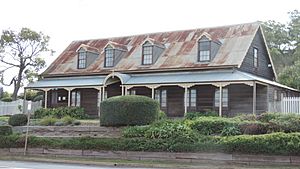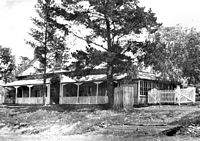Royal Bull's Head Inn facts for kids
Quick facts for kids Royal Bull's Head Inn |
|
|---|---|

Royal Bull's Head Inn, 2015
|
|
| Location | Brisbane Street, Drayton, Toowoomba Region, Queensland, Australia |
| Design period | 1840s–1860s (mid-19th century) |
| Built | 1859–1950s |
| Official name: Royal Bull's Head Inn, Bull's Head Hotel | |
| Type | state heritage (archaeological, built) |
| Designated | 21 October 1992 |
| Reference no. | 600838 |
| Significant period | 1850s (fabric) 1847–1879 (historic use as hotel site) 1892–1952 (use as post office) |
| Significant components | out building/s, furniture/fittings, kitchen/kitchen house, pathway/walkway, well, trees/plantings, terracing |
| Lua error in Module:Location_map at line 420: attempt to index field 'wikibase' (a nil value). | |
The Royal Bull's Head Inn is a very old and important building in Drayton, Australia. It was built a long time ago, starting in 1859, and was once a famous hotel. Today, it is looked after by the National Trust of Queensland and is a special museum. It helps us understand what life was like in Queensland many years ago.
Contents
A Look Back: The Inn's Story
How Drayton Began
In the early 1840s, people started settling in the Darling Downs area. A man named Thomas Alford opened a store near some important travel routes. This spot was known for its water springs and was called "The Springs." Soon, other businesses, like blacksmiths, opened there to help the farmers and travelers.
William Horton's Famous Hotel
In 1847, a man named William Horton built a really nice hotel at "The Springs," which was then called Drayton. Horton had experience running hotels and wanted his new place to be known for comfort. He named it the 'Bull's Head' after a prize bull named "Champion" from a nearby farm.
The hotel quickly became a popular spot. Farmers and travelers would meet there, stay the night, and even hold auctions and parties. It was a busy place with a parlor and everything needed for many visitors. Important meetings, even about how the state was run, happened there. In 1848, the first Church of England service in the Darling Downs was held at the inn.
Drayton vs. Toowoomba
Drayton grew, but it had a big problem: not enough water. Wells were dug, but they didn't solve the issue. Meanwhile, a new area called "The Swamp," about 6.5 kilometers away, was growing fast. It had plenty of water and good soil for farming. It was also closer to a new, easier road over the mountains.
By 1852, William Horton was planning another hotel at "The Swamp." This new town, later named Toowoomba, started to become more important than Drayton.
The Royal Extension
Horton returned to Drayton in 1858 and made a big addition to the Bull's Head Inn. He used brick, cedar, and timber to make it even grander. The whole inn was beautifully furnished. People said it was the best hotel on the Darling Downs, even better than some in Brisbane and Ipswich.
In March 1860, the new Queensland Governor, Sir George Bowen, stayed at the inn. After this important visit, the hotel was renamed the Royal Bull's Head Hotel. More improvements followed, like a billiard room and new stables in 1861.
Changes Over Time
William Horton passed away in 1864. Without his personal touch, the hotel slowly became less popular as Drayton itself declined. In 1875, most of the original 1847 building and the stables were sold off. Only the 1859 extension and the old kitchen remained. These are the parts of the building you see today.
In 1879, William Horton's son sold the inn to Richard Stephen Lynch and his wife Sarah. The hotel stopped being a hotel and became the Lynch family's home, which they called "The Terrace." The Lynch family lived there for over 90 years. They also ran the Drayton Post Office from the building for 60 years, until 1952.
Becoming a Museum
In 1973, the last Lynch family member living there, Alan Campbell Lynch, passed away. The National Trust of Queensland bought the building. They worked hard to restore it, bringing it back to how it looked as a wayside inn.
Archaeologists have studied the grounds, finding clues about the 1847 building and how the inn operated. The inn opened to the public as a museum, showing what life was like in the past.
Many celebrations have taken place at the inn since its restoration. In 1988, the Governor of Queensland, Sir Walter Campbell, officially opened the restored Royal Bull's Head Inn. Restoration work on the building and its gardens is still ongoing today.
Famous Guests
- Governor of Queensland George Bowen
- Archbishop John Polding
What the Inn Looks Like
The Royal Bull's Head Inn is a two-story building made of timber and brick. It has walls made of weatherboard (overlapping wooden boards) and chamferboard (boards with angled edges). Inside, the ground floor has brick walls. There are ten rooms downstairs and five upstairs.
The roof is made of corrugated iron and has four dormer windows (windows that stick out from the roof). These windows are a well-known feature of the building.
The old kitchen building is still there at the back, though it's in ruins. A well, possibly from when it was a hotel, is also near the back of the inn.
The grounds around the inn are still quite large. They include gardens and other structures added by the Lynch family, as well as some old plants. Parts of the stone terraces from the hotel days are still visible. Fences have been rebuilt to look like they did in the past.
Inside, you can see furniture and items that belonged to the Lynch family. Some original features remain, like wallpaper on calico scrim (a type of fabric) stretched between the wooden studs upstairs. Many of the wooden fittings are original, and some even have painted scenes. The pressed metal ceiling in the parlour is also still there.
Why It's Special
The Royal Bull's Head Inn is listed on the Queensland Heritage Register because it's a very important part of Queensland's history.
- Shows Queensland's Past: It helps us understand the early days of European settlement in the Darling Downs when Drayton was a key town on a major trade route.
- A Rare Old Building: It's one of the few inns left from before Queensland became its own colony (before 1859). Its building style also shows old and uncommon construction methods.
- Teaches Us About History: Because it's so old and well-preserved, it can teach us a lot about how people lived and worked in early Queensland.
- A Great Example: The inn, its rooms, and the surrounding grounds show us exactly what a busy inn complex would have looked like back then.
- Beautiful to See: Many people in the community find the building and its setting very beautiful.


